Brittle and Nonbrittle Environments
In a nutshell, nonbrittle environments usually have sufficient moisture throughout the growing season to promote decay of old vegetation and the germination of new seedlings. Brittle environments on the other hand, tend to dry out quickly, interrupting the processes of decay and seedling germination. Understanding the difference between brittle and nonbrittle environments is critical to effective weed management.
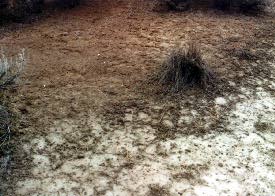
| Capped soil in the front and freeze-thawed soil in the back surround a final stand of dead, oxidizing grass. Without organic matter on the soil to capture moisture, half or more of the rain that falls can wash away without soaking into the ground. Animal impact would enable new seedlings to germinate and recolonize this ground. Bennet Hills, Idaho. |
Most weeds thrive in exposed soils where there is little competition from other plants. To create a landscape of high-quality plant species it is necessary to optimize the use of available water to stimulate the germination and growth of desirable plants that can compete with weeds. Effective use of available moisture is especially important in environments where rainfall is unpredictable.
All environments exist somewhere on a scale between being brittle or nonbrittle. The distinction between one and the other is not so much a measure of the quantity of moisture received, but how that moisture is distributed across time and geographic space. You might think that a region averaging 50 inches of moisture per year would be a rain-forest, but what if all that moisture came in one month, and the rest of the year was dry?
The degree of brittleness in an environment is largely a factor of how predictable the rains are there. The Kalahari Desert in southern Africa is extremely brittle; the total amount of precipitation can vary as much as 500% from year to year. Even when a region does receive its average annual precipitation, the moisture may be unevenly distributed across local geographic space. Many of the photos shown here were taken in Idaho in the Great Basin Desert, where precipitation is similarly unpredictable and may vary from as little as 3 inches in some years to nearly 20 inches in other years.
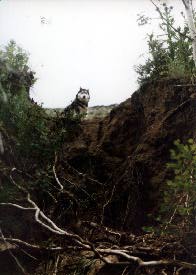
| The soil lost in this washout along the road is visible and obvious, but trivial compared to the amount of soil lost every year as a result of having bare ground between each and every plant. Pony, Montana. |
The regularity of precipitation in a nonbrittle environment allows bacteria to break down old vegetation and gives new seedlings a chance to grow, almost regardless of how the land is treated. A brittle environment, however, requires animal impact to trample organic matter into the soil to trap the necessary moisture to promote bacterial action and facilitate the growth of new seedlings. Half of the moisture that falls on the land can easily be lost if there is insufficient organic matter on the ground to capture it. That means that a region that receives twenty inches of precipitation in a year may get only ten inches of benefit!
Altering the sequence of grazing in extreme brittle environments leads to phenomenal changes. A lack of sufficient animal impact can quickly lead to a denuded landscape where falling precipitation simply washes away across the bare ground, causing floods downstream. The water by-passes the water table, and age-old springs and streams dry up and disappear. As incredulous as it seems, merely restoring or mimicking the historical sequence of grazing leads to a reversal of desertification-where dry springs and creeks come alive again, and the denuded landscape comes back to life.
Most of Montana is not nearly as brittle as the Great Basin Desert or the Kalahari, so the process of desertification proceeds more slowly here, but already we have lost inches of valuable soil from the hills, and there are ever wider spaces between the remaining plants.
It is important to understand that brittleness can vary even over very small areas. The north and south slopes of a hill may receive the same amount of precipitation, yet the level of brittleness may vary considerably, due to the angle of the topography to the sun. Sunlight strikes the south-facing slopes directly during all times of the year, quickly melting winter snows and drying up summer rains. Most south-facing slopes are moderately brittle. North-facing slopes however, are moderately nonbrittle since they receive almost no sunlight in winter, and only indirect sunlight in summer. Moisture is therefore retained through most of the critical growing season.
In a nonbrittle landscape there is sufficient moisture available for bacteria to quickly break down dead tissues so that other living plants can utilize the nutrients. Extreme nonbrittle environments like tropical rainforests have enough warmth and moisture for bacteria to recycle nutrients "in the air". Dead material is broken down and then consumed by other plants without falling to the ground or entering the soil. Therefore the soil under tropical rainforests is usually almost barren of nutrients.
The process of decay becomes progressively slower as one moves towards brittle environments. In the moderately nonbrittle environments common across Montana, most dead matter falls and rots into the soil before the nutrients are used by other plants. Some of our mildly nonbrittle lands almost require periodic fires to break down large, woody material to release the nutrients.
Standing dead vegetation in a brittle environment decomposes very slowly through a process called oxidation. Severe animal impact is required to trample the dead matter into the ground where bacteria can beak it down.
Surprisingly, although nonbrittle environments produce copious quantities of biomass, there are usually very few animals associated with it. True brittle environments on the other hand, require animal life to effectively recycle nutrients. Bacteria are unable to decompose old vegetation until it is flat on the ground. Conventional range management allows livestock to spread out loosely on the landscape, so the animals walk gently around old plants in search of tender, young shoots.
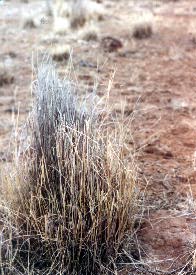
| Standing dead vegetation in a brittle environment decomposes very slowly through a process called oxidation. Severe animal impact is required to trample the dead matter into the ground where bacteria can break it down. |
To effectively break down old vegetation requires concentrated animal impact, which is usually accomplished by putting more animals in a smaller space for shorter periods of time. Additional impact may be achieved by herding the animals, or by putting feed or supplements in areas where impact is especially desired. The impact of the animals effectively breaks down old plants while also inoculating the landscape with bacteria in the form of manure. Animal impact should ideally break up the manure as well, to further speed the recycling of nutrients.
Fire is often used to remove and recycle dead vegetation, but extreme caution should be used in brittle environments. Burning sends a nutrient flush into the soil and invigorates new growth--but it also leads to bare ground, and vital nutrients may be washed away with the rain. Moreover, part of the apparent vigor of the plants is merely an optical illusion: the green is simply more visible when dead matter is removed.
Another facet of effective mineral cycling is to maintain a diversity of plant species that are capable of pulling nutrients up from different depths in the soil. Grasses for instance, have very shallow roots while legumes, like alfalfa have roots that can penetrate fifty or more feet in search of water and nutrients. These long roots capture nutrients that would otherwise leach down beyond the root zone. The nutrients are brought back to the surface and ultimately recycled back to other plants.
Many invasive weeds are especially adapted to depleted soils. Maintaining an effective mineral cycle can help achieve the necessary fertility and growth to allow more desirable plant species to compete with invasive weeds.
Succession in Brittle and Nonbrittle Environments
If you were to take a shovel and turn over a patch of sod and then leave it for a year, you would discover that the plants that colonized the disturbed soil were different from the ones that were there before. The site would first be covered by weedy, "pioneer plants" with carrot-like tap-roots, followed by a succession of new plants over the years. The tap-rooted weeds would eventually disappear, and the site would return to sod, with many small roots tightly holding the soil in place.
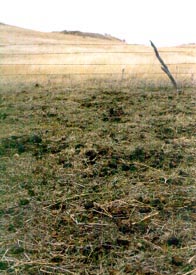
| The pasture in the foreground was heavily grazed by horses, effectively peppering the ground with manure and other organic matter to protect and fertilize new seedlings. Notice that organic matter in the back pasture has not been recycled. |
This is the process of succession, where bare surfaces are pioneered by certain species, then gradually replaced with waves of new species as the habitat becomes tighter and more stable. In a nonbrittle environment, given enough time, bare ground will progress from weeds to rangeland, to deciduous forest, and will climax as an evergreen forest. Fire may eventually consume the forest and restart the successional process.
The key difference between succession in nonbrittle and brittle environments is that nonbrittle environments can mature with or without the presence of hoofed animals, but brittle environments require hooves on the soil to stimulate the successional process. Amazingly, without animal impact, succession will reverse in even a mature brittle environment, leading towards more tap-rooted weeds and bare ground.
The ground is always covered with the seeds of many different plants, but the conditions at any one time only favor certain species to germinate and grow. Creating a landscape of desirable plants is largely a matter of manipulating habitat to favor the plants we want. Most often there is no need to put a lot of money or labor into seeding rangeland. Plants reproduce exponentially, so one seed can become a plant with hundreds more seeds, and each of those seeds can become plants totaling many thousands more seeds. Once the conditions become favorable to a particular species it will take over and spread "like a weed".
Eight years ago it was difficult to find a wild onion growing on the dry hill behind our house. But early one spring while digging soil for flower pots, I realized just how badly the hillside had deteriorated. Wild onions are a low successional species that requires bare ground to germinate. After eight years of continuous rest there was so much bare ground between the plants that the wild onions were sprouting by the hundreds just in the small area where I was filling flower pots.

| A foot print sinks deep into the puffy soils left from repeated cycles of freezing and thawing. Air moves easily through the soil and steals the moisture before seeds can germinate. Animal impact can compact the soil and allow seeds to germinate. Bennet Hills, Idaho. |
I worked in the Great Basin Desert of Idaho for some time where the wild onions grew by the tens of thousands across the denuded landscape. Like other low-successional species, they have a short growing cycle. Onions are among the first plants to turn green in the spring. They grow fast, bloom early and set seed almost by the beginning of summer. They are adapted to exposed soils where rain water quickly runs off the land, and any remaining moisture is easily dried up by the sun. The plants are done and dead early in the season while higher-successional plants are just getting started. The onions have spread "like weeds", only because the habitat is in their favor. Merely manipulating the soil with hooves would tighten the plant cover, and the onions would disappear as quickly as they came.
Don and Cleo Shaules, ranchers near Billings carefully managed their livestock to advance succession on their land. Heavy animal impact successfully trampled cactus and sagebrush into the dirt, while "roto-tilling" the soil to favor new seedlings. The rich, brown soil humus increased from 1/4 inch up to 1 1/2 inches in ten years, and the Shaules have been able to more than double their livestock numbers.
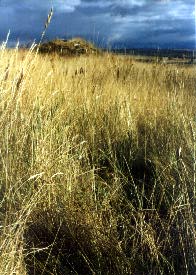
| Our one cow experiment led to a much tighter plant cover. |
Like anyone else, we have had higher priorities in life than to worry about the exposed soil between the plants on our land. Nevertheless, we did have a "herd" of one cow for almost a year. Based on a tip from Cliff Montagne, associate professor of soil science at MSU-Bozeman, we wintered our cow on the worst part of the property, then put hay and mulch out in a different place each day. Some of the hay and mulch was eaten, and the rest was trampled into the soil. We moved the cow in spring, and there was an explosion of new seedlings all across the site. Some parts of the pasture were in decent condition already; these areas became so thick with grass that they were a little bit difficult to walk through. Other parts of the pasture started out as almost entirely bare ground, with only a handful of weeds, mostly mustards. These sections were the farthest from the hay stack, and therefore got little hay or mulch, but lots of hoof action. The weeds that were there exploded in population, but that was okay because they were "pioneer plants". The soil was not yet ready to support higher-successional species. If we had continued the experiment over a number of years, we would have seen the grasses and other forage plants move in to colonize the site.
It is important to understand that fire restarts the successional process, preventing rangelands from maturing into brush or forest. In a nonbrittle landscape like the eastern prairies, fires historically swept through, consuming both the tall grasses and the fledgling hardwood trees to maintain the grass prairie. Homesteading put an end to the natural fires and allowed the forests to expand across uncultivated areas along the margins of farms. Brittle lands, on the other hand, may not have enough total moisture to support woody cover, and a tight growth of range plants may be the highest level of succession possible. Fire sets the successional process to it's lowest level, and only the impact of animal hooves can restore a high level of succession.
 Also note that although the land may appear greener and healthier in wet years, the process of desertification continues. The range plants and the weeds may be taller, but look down between the plants and there will be just as much bare ground as before.
Also note that although the land may appear greener and healthier in wet years, the process of desertification continues. The range plants and the weeds may be taller, but look down between the plants and there will be just as much bare ground as before.
Much of the information presented here was inspired by Allan Savory in his book, Holistic Management: A New Framework for Decision Making.
Continue with Grazing Weeds with Sheep